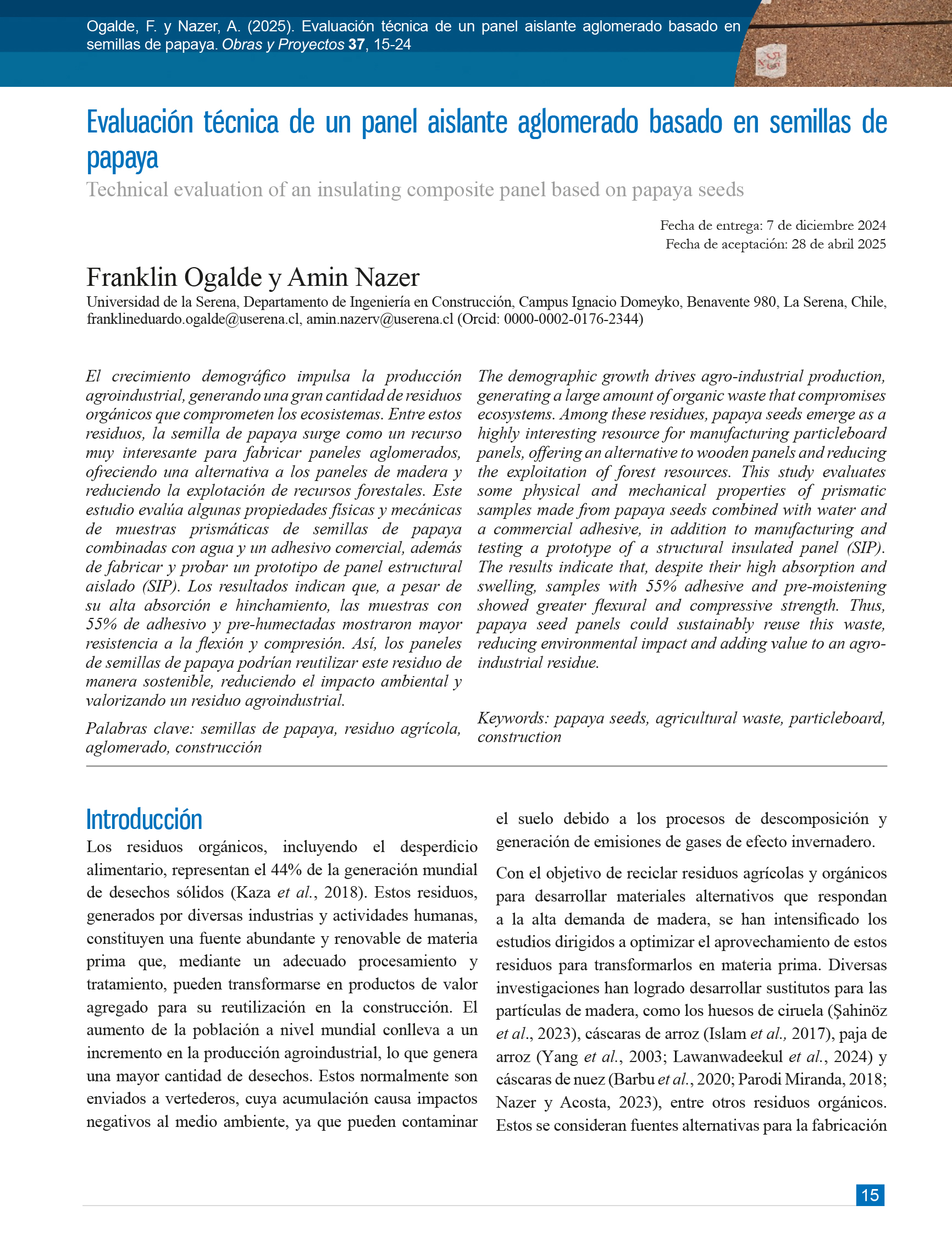Technical evaluation of an insulating composite panel based on papaya seeds
DOI:
https://doi.org/10.21703/0718-2813.2025.37.3232Keywords:
Papaya seeds, Agricultural waste, Particleboard, ConstructionAbstract
The demographic growth drives agro-industrial production, generating a large amount of organic waste that compromises ecosystems. Among these residues, papaya seeds emerge as a highly interesting resource for manufacturing particleboard panels, offering an alternative to wooden panels and reducing the exploitation of forest resources. This study evaluates some physical and mechanical properties of prismatic samples made from papaya seeds combined with water and a commercial adhesive, in addition to manufacturing and testing a prototype of a structural insulated panel (SIP). The results indicate that, despite their high absorption and swelling, samples with 55% adhesive and pre-moistening showed greater flexural and compressive strength. Thus, papaya seed panels could sustainably reuse this waste, reducing environmental impact and adding value to an agroindustrial residue.
References
ASTM D1037-12 (2020). Standard test methods for evaluating properties of wood-base fiber and particle panel materials. ASTM International, West Coshohocken PA, USA.
Barbu, M.C., Sepperer, T., Tudor, E.M. and Petutschnigg, A. (2020). Walnut and hazelnut shells: Untapped industrial resources and their suitability in lignocellulosic composites. Applied Sciences 10(18), 6340.
Carvalho, F. and Renner, S.S. (2015). A dated phylogeny of the papaya family (Caricaceae) reveals the crop’s closest relatives and the family’s biogeographic history. Molecular Phylogeny, Biogeography and an e-Monograph of the Papaya Family (Caricaceae) as an Example of Taxonomy in the Electronic Age. Springer Spektrum, Germany, 49-81.
FAO (2023). Crops and livestock products. Consultado el 10 de octubre de 2024 (www.fao.org/faostat)
Hueso, J.J., Salinas, I. and Cuevas, J. (2015). El cultivo de la papaya. Cajamar ADN Agro. España.
Islam, M.S., Kao, N., Bhattacharya, S.N., Gupta, R. and Bhattacharjee, P.K. (2017). Effect of low pressure alkaline delignification process on the production of nanocrystalline cellulose from rice husk. Journal of the Taiwan Institute of Chemical Engineers 80, 820-834.
Kaza, S., Yao, L. C., Bhada-Tata, P. and van Woerden, F. (2018). What a waste 2.0: A global snapshot of solid waste management to 2050. World Bank, Washington DC, USA.
Lawanwadeekul, S., Jun-On, N., Kongthavorn, P., Sangkas, T. and Daothong, S. (2024). Chemical-free thermal-acoustic panels from agricultural waste for sustainable building materials. Cleaner Materials 12, 100245.
Morales-Quintana, L., Fuentes, L., Gaete-Eastman, C., Herrera, R. and Moya-León, M.A. (2011). Structural characterization and substrate specificity of VpAAT1 protein related to ester biosynthesis in mountain papaya fruit. Journal of Molecular Graphics and Modelling 29(5), 635-642.
Moreno, J., Bugueño, G., Velasco, V., Petzold, G. and TabiloMunizaga, G. (2004). Osmotic dehydration and vacuum impregnation on physicochemical properties of Chilean papaya (Carica candamarcensis). Journal of Food Science 69(3), 102-106.
Moya-León, M. A., Moya, M. and Herrera, R. (2004). Ripening of mountain papaya (Vasconcellea pubescens) and ethylene dependence of some ripening events. Postharvest Biology and Technology 34(2), 211-218.
Muñoz, M. (1988). Nomenclatura del papayo cultivado en Chile. Agricultura Técnica 48(1), 39-42.
Nazer, A. y Acosta, C. (2023). Uso de la cáscara de nuez en la fabricación de aglomerados. Obras y Proyectos 34, 92-99.
Parodi Miranda, D. (2018). Material compuesto a partir del residuo cáscara de nuez Juglans regia. Revista Chilena de Diseño: Creación y Pensamiento 3(5), 1–13.
Şahinöz, M., Aruntaş, H. and Gürü, M. (2023). Production of composite particleboard from waste plum pits (Prunus domestica) and improvement of its characteristics. Cellulose Chemistry and Technology 57(5-6), 587-598.
Salvatierra, A. y Jana, C. (2014). Situación actual del cultivo de papayos en las principales zonas de producción. Tierra Adentro 107, 55-61.
Smith, R.E. (2011). Prefab architecture: A guide to modular design and construction. John Wiley & Sons, Hoboken NJ, USA.
Tasdemir, H.M., Sahin, A., Karabulut, A.F. and Guru, M. (2019). Production of useful composite particleboard from waste orange peel. Cellulose Chemistry and Technology 53(5-6), 517-526.
Yang, H.S., Kim, D.J. and Kim, H.J. (2003). Rice straw–wood particle composite for sound absorbing wooden construction materials. Bioresource Technology 86(2), 117–121.

Downloads
Published
Issue
Section
License
Copyright (c) 2025 Universidad Católica de la Santísima Concepción

This work is licensed under a Creative Commons Attribution-NonCommercial 4.0 International License.







